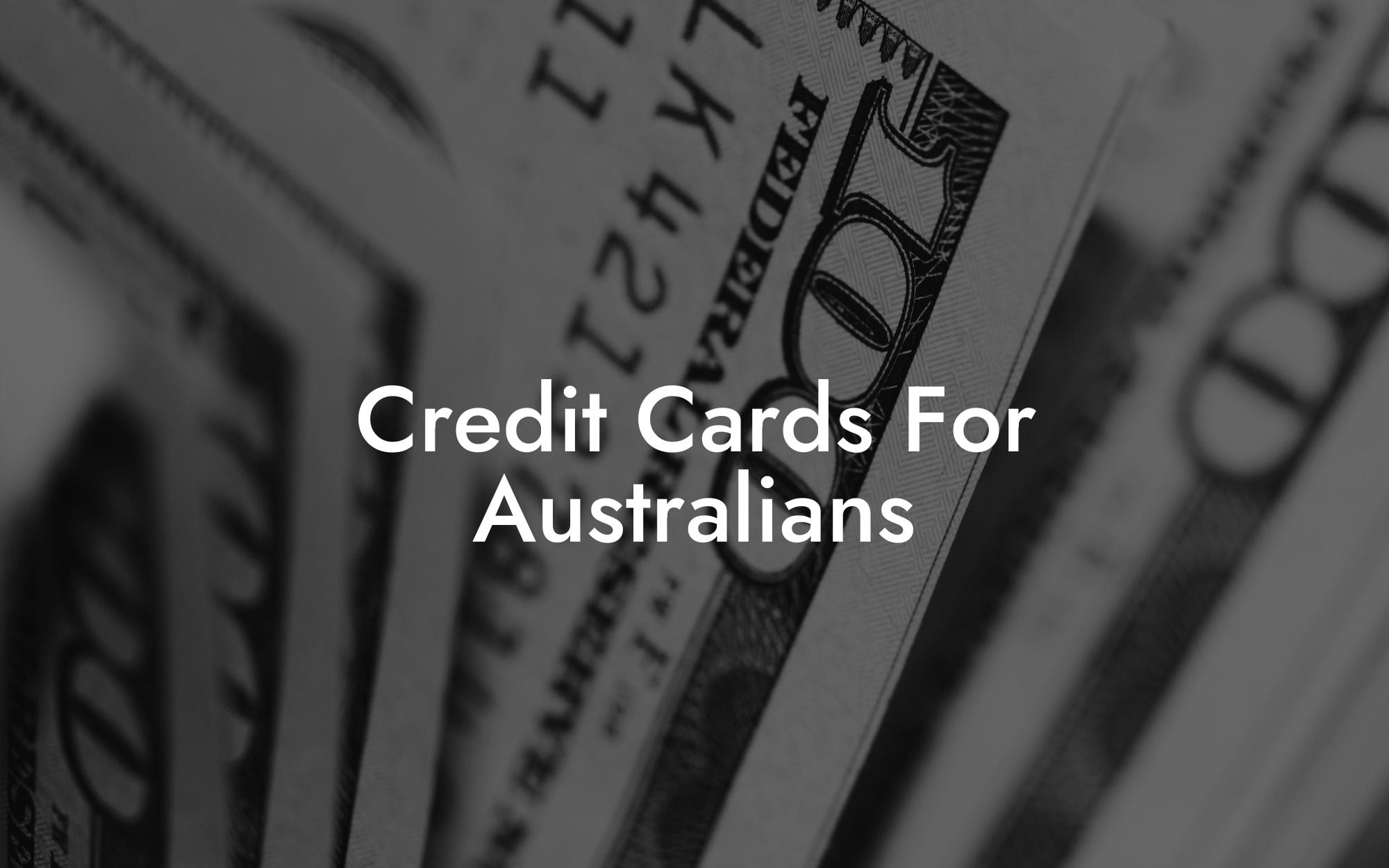Picture this: you’re at a cool rooftop bar in Sydney, cocktail in hand, and your phone buzzes with a notification alerting you to a shiny new reward offer on your credit card. You smile because you know your financial game is on point—and that’s exactly what “Credit Cards For Australians” is all about. Whether you’re a millennial juggling multiple side hustles or a Gen Z adventurer looking for the best cashbacks without drowning in debt, this guide is here to make the maze of credit options not only understandable but downright enjoyable. Let’s dive into the world of plastic, perks, and financial freedom.
Credit Cards For Australians Table of Contents
Understanding Credit Cards in Australia
The Perks and Pitfalls: What You Need to Know
Types of Credit Cards Tailored for Australians
How to Choose the Perfect Credit Card for Your Lifestyle
Top Credit Card Options for Millennials and Gen Z in Australia
Strategies for Responsible Credit Card Use
Real-Life Stories: How Australians Are Winning with Credit Cards
Smart Tips and Tricks for Maximizing Your Credit Card Benefits
Resources and Community Support: Your Next Steps
Your Blueprint for a Financially Empowered Future
Understanding Credit Cards in Australia
Australian credit cards are like a fine espresso—they come in many flavors, each with its own unique blend of benefits and bold risks. From cashback rewards, travel points, and low interest introductory offers, to premium perks that make you feel like a VIP, there is a card out there for every lifestyle. But before you start swiping your way to riches, it’s crucial to understand how these cards work, the basics of interest rates, fees, and how to read the fine print without needing a finance degree.
In Australia, credit cards are more than just tools for purchasing coffee or that must-have online gadget. They’re financial instruments designed to build your credit history, offer purchase protection, and even reward you for spending your hard-earned dollars wisely. They can open doors to better financial opportunities down the line, but only if you use them responsibly.
The key is knowing what you’re signing up for. A credit card isn’t just a piece of plastic; it’s a commitment to disciplined spending and timely payments. With a bustling market full of competitive offers, understanding the terms and features of different cards can help you avoid hidden fees, skyrocketing interest, and financial pitfalls that could leave you scrambling.
Think of credit cards as trusty sidekicks in your financial journey. They demand respect, require smart management, and when used properly, provide amazing benefits that might even turn a rainy day into an opportunity for rewards.
The Perks and Pitfalls: What You Need to Know
Credit cards are like having a superpower if you learn how to harness them correctly. Let’s break down the main benefits and risks that come with credit cards in Australia.
Major Benefits
Building Your Credit Score: Every on-time payment can boost your credit score, helping you secure better loan terms and even impress prospective landlords.
Rewards and Cashback: Think about earning a percentage back on your grocery runs and coffee fixes. Many cards offer rewards that can be redeemed for travel, merchandise, or more cash in your pocket.
Travel Perks: Frequent flyers can benefit from cards that offer bonus points, priority boarding, lounge access, or even free checked bags.
Purchase Protection: Some credit cards come with built-in insurance, extended warranties, and fraud protection, ensuring that your purchases are safeguarded against unexpected mishaps.
Potential Pitfalls
High Interest Rates: The flip side of credit perks can be steep interest rates if you carry a balance. It’s like enjoying a free dessert that comes with an unending bill.
Annual Fees: Some premium cards charge annual fees that might not be worth it if you don’t maximize the rewards or perks available.
Late Payment Penalties: Miss a payment and face penalties that can quickly spiral into a financial mountain you never intended to climb.
Overuse Temptation: With a credit limit that might make you feel like a high-roller, it’s easy to overspend and potentially fall into the trap of debt.
Understanding these benefits and risks is the first step in making informed decisions. Whether you’re aiming to splurge on that dream vacation or simply looking to pay off high-interest debt, having a clear picture of what credit cards offer will help you navigate the landscape with confidence.
Types of Credit Cards Tailored for Australians
Australia’s credit card market is as diverse as its stunning landscapes—from coastal paradises to vibrant urban centers. Here’s a rundown of the most popular types of cards you might consider:
Cashback Credit Cards
Perfect for those who love to see instant rewards, cashback cards refund a portion of your spending—typically on everyday purchases like groceries and fuel. They’re ideal for the pragmatic spender who appreciates tangible, immediate benefits.
Rewards Credit Cards
If you’re more into accumulating points that you can convert to flights, hotel stays, or even the latest tech gadgets, rewards credit cards are your best bet. These cards often come with travel perks and exclusive member benefits.
Low-Interest Credit Cards
For those pesky times when you might need to carry a balance, low-interest cards can save you substantial dollars in interest fees. They are particularly useful if your cash flow is unpredictable.
Balance Transfer Credit Cards
Drowning in high-interest debt? Balance transfer cards allow you to transfer existing debt at a lower interest rate for a promotional period—giving you space to consolidate and pay down your balance without the pressure of high fees.
Student Credit Cards
Tailored specifically for university students and young professionals, these cards often offer lower credit limits and fewer fees, making it easier to build credit without the worry of overspending.
With so many options, the key is to match your spending habits, lifestyle, and financial goals with the best type of credit card available.
How to Choose the Perfect Credit Card for Your Lifestyle
Choosing a credit card isn’t a one-size-fits-all affair—it’s more like picking the right pair of sneakers for a marathon versus a casual stroll in the park. Here are some tips to help you zero in on the best match:
Analyze Your Spending Habits
Start by taking a good, hard look at your monthly expenses. Do you spend a lot on dining out, travel, or online shopping? Or are you more of a fuel and grocery spender? Knowing where the majority of your money goes can highlight which rewards or cashback schemes will benefit you the most.
Consider Your Financial Goals
Are you using a credit card to build your credit score for future home loans? Or perhaps you’re focused on maximizing rewards for travel and leisure? Having clear goals will help you decide on features like introductory interest rates, rewards programs, and additional perks.
Scrutinize the Fees and Rates
It’s easy to be dazzled by an attractive rewards offer, but always check the fine print. Compare annual fees, interest charges, and any hidden costs. Remember, the best credit card for you is the one whose overall cost aligns with the benefits it offers.
Flexibility and Perks
Look for cards that offer flexibility in terms of redeeming rewards and a range of additional benefits like travel insurance, purchase protection, and concierge services. These extras can add significant value to your everyday spending.
Promotional Offers
Keep an eye out for introductory offers like 0% interest periods or bonus points. These promotions can provide a substantial head start, especially if you plan to make large or planned purchases.
By taking these factors into account, you can narrow down the choices to a card that seamlessly fits into your lifestyle, helping you manage your finances smartly while enjoying all the perks that come with it.
Top Credit Card Options for Millennials and Gen Z in Australia
Whether you’re fresh out of uni or already climbing the career ladder, the market is brimming with credit card options designed with your generation in mind. Let’s check out some of the top contenders:
1. The Cashback Champion
Designed for everyday spending, the Cashback Champion rewards you for every dollar spent on essentials like groceries, transport, and dining. With a straightforward rewards system and minimal fees, it’s a hit among those who prefer simplicity and immediate benefits.
2. The Travel Tribe Card
Calling all wanderlusters—this card features generous rewards for travel-related expenses. From earning bonus points on flight bookings to access to exclusive airport lounges, the Travel Tribe Card is perfect for the global citizen who wants to turn ordinary purchases into extraordinary adventures.
3. The Low-Interest Lifesaver
For those periods when life isn’t as predictable, the Low-Interest Lifesaver offers some breathing room. With an introductory period of 0% interest on purchases or balance transfers, it’s a great option for consolidating debt or handling unexpected expenses.
4. The Student Starter Card
Tailored for university students and young professionals, the Student Starter Card typically comes with lower fees and smaller credit limits—ideal for building credit without the risks of overspending. Plus, it often includes educational tools and budgeting tips to keep finances on track.
5. The Premium Perks Card
For those willing to invest a bit more for a wealth of benefits, the Premium Perks Card offers a robust package including concierge services, travel insurance, and exclusive rewards on high-value purchases. This card suits young professionals who crave luxury and additional services along with their spending power.
When reviewing these options, remember that credit cards are as diverse as the people who use them—what works brilliantly for one person might not be the best fit for another. It’s all about aligning a card’s features with your unique financial habits and future aspirations.
Strategies for Responsible Credit Card Use
Using a credit card responsibly is like mastering the art of juggling flaming torches—you can perform dazzling feats if you’ve got the skills, but one misstep and the results can be chaotic. Here are some strategies to ensure you’re always in control of your financial circus:
Set a Budget and Stick to It
The first step in responsible credit card use is establishing a realistic budget. Track your monthly income and expenses, and decide how much you can comfortably pay off each month without compromising your savings. Budgeting apps and financial tools can make this process less stressful and help you keep an eye on your spending.
Pay Your Balance in Full
Whenever possible, aim to pay your balance in full at the end of each billing cycle. This not only prevents the accumulation of interest but also reinforces disciplined spending habits. If paying in full isn’t feasible, make sure to pay more than the minimum to reduce the interest burden.
Monitor Your Credit Card Statements
Keep a close eye on your statements for any errors, fraudulent charges, or unexpected fees. Regular monitoring can help you spot issues early and ensure that you’re always aware of your financial standing.
Understand Your Terms and Conditions
Taking the time to thoroughly read and understand your credit card’s terms and conditions may seem tedious, but it can save you from hidden fees and surprises down the road. Look out for details on interest rates, late payment fees, foreign transaction fees, and any other charges.
Use Alerts and Reminders
Most banks offer customizable alerts—these can remind you about upcoming payment due dates, large transactions, or when you’re approaching your credit limit. Leveraging technology in this way can help you maintain a healthy credit profile without having to babysit your account 24/7.
Ultimately, responsible credit card use is all about balance: enjoying the perks while staying within your means. With clear strategies in place, you can make the most of your card and build a solid financial future.
Real-Life Stories: How Australians Are Winning with Credit Cards
Sometimes, the best way to learn is from those who’ve walked the walk. Here are some real-life examples of Aussies who have leveraged credit cards to boost their financial wellbeing:
Case Study 1: Emily’s Cashback Journey
Emily, a young marketing professional in Melbourne, was always on the lookout for ways to optimize her spending. After switching to a cashback card that suited her daily expenses, she began to see a steady stream of rewards—a percentage back on everything from her morning latte to her monthly grocery run. Over time, those cashback rewards allowed her to build a savings buffer while maintaining a vibrant social life.
Case Study 2: Jack’s Travel Transformations
Jack, a digital nomad from Brisbane, used a travel rewards credit card to fund his globe-trotting adventures. By strategically planning his expenses and maximizing bonus point offers, Jack managed to earn free flights to Bali, discounted accommodation options, and access to airport lounges across Asia. His balanced approach to travel and mindful spending shows just how transformative the right credit card can be.
Case Study 3: Sarah’s Smart Student Start
As a recent university graduate in Perth, Sarah was cautiously stepping into the adult financial world. She started with a student credit card that not only helped her build credit history but also offered useful budgeting tools and low fees. By keeping her spending in check and paying off her balance every month, Sarah managed to maintain a sparkling credit record, setting her up for future financial successes like buying her first car.
These stories highlight that regardless of your financial stage—whether you’re just starting out or already established—there’s a credit card strategy that can work wonders for you. The secret lies in combining smart spending habits with a deep understanding of your card’s benefits.
Smart Tips and Tricks for Maximizing Your Credit Card Benefits
Ready to become a credit card connoisseur? Here are some clever tricks to truly optimize your spending and build financial muscle:
Plan Your Purchases Around Bonus Periods
Many credit cards offer bonus rewards during specific months or for certain spending categories. Keep an eye on such promotions and try to schedule your larger purchases during these periods for an extra boost in rewards points or cashback.
Leverage Introductory Offers
Don’t be scared of those 0% interest offers and bonus point deals. Use these promotions as a springboard for consolidating debt or making planned purchases—just be sure to understand when the introductory period ends, so you aren’t caught off guard by increased rates.
Combine Your Cards Strategically
Some savvy Aussies use more than one credit card to maximize returns on different types of spending. Use a cashback card for everyday expenses while a travel rewards card can cover your holiday bookings or significant lifestyle expenses. Just remember to track your spending across all cards to stay within budget.
Take Advantage of Mobile Apps and Alerts
Most banks offer mobile apps that let you manage your credit card accounts on the go. Use them to set up payment reminders, monitor transactions, and even scan receipts for expense tracking. It’s a modern way to stay on top of your finances without constantly worrying.
Negotiate with Your Issuer
Don’t hesitate to call up your credit card company to ask if you qualify for a lower interest rate or fee waiver—especially if you’re a loyal customer with a strong payment history. A little negotiation can sometimes lead to significant savings over time.
These insights are like little life hacks for your wallet, showcasing that with informed decisions and a proactive approach, you can turn your credit card into a powerful asset in your financial toolkit.
Resources and Community Support: Your Next Steps
Embarking on your credit card journey is an empowering move, and you’re not alone in this process. There are numerous resources to help elevate your financial literacy and connect you with a community of like-minded Aussies who share your financial aspirations.
Financial Literacy Websites and Blogs: Websites like Canstar, Finder, and Mozo provide comparisons, expert insights, and reviews on the latest credit card offerings in Australia. They’re great starting points for understanding the nuances of different products.
Online Forums and Social Media Groups: Join communities on platforms such as Whirlpool or Facebook groups dedicated to personal finance. Many millennial and Gen Z audiences share tips, experiences, and advice, making it a supportive space to discuss budgeting, rewards optimization, and even personal finance success stories.
Financial Advisors and Workshops: If you feel overwhelmed, consider seeking advice from a dedicated financial advisor or participating in local workshops. Many experts now offer online sessions tailored for younger Australians who are eager to learn the ins and outs of credit management.
Apps and Tools: Explore budgeting apps like Pocketbook, MoneyBrilliant, or Even use your bank’s proprietary app. These tools can help track your spending, set limits, and even remind you of due dates so that you never miss a payment.
Taking the next step in managing your credit smartly means tapping into these supportive networks and continually educating yourself about financial trends. Remember, every pro was once a beginner, and the best way to grow is to keep learning and sharing.
Your Blueprint for a Financially Empowered Future
Now that you’re armed with the insights into credit cards in Australia, it’s time to put theory into practice. The journey to financial empowerment is less about quick fixes and more about building a sustainable, long-term strategy that fits your lifestyle. Every swipe, every reward, and every enlightened decision takes you one step closer to a secure financial future.
Think of your credit card as a trusty sidekick in your financial adventure—it can help you seize opportunities, unlock rewards, and even keep you prepared for unexpected expenses if managed wisely. Like any formidable tool, its true power lies in your hands. Make informed choices, remain disciplined, and turn potential pitfalls into stepping stones towards success.
So, whether you’re planning a once-in-a-lifetime trip, setting up an emergency fund, or just getting started on building a solid credit score, remember that every financial decision is a building block for your future. Channel your inner financial ninja, ready to conquer challenges with humor, savvy, and newfound confidence.
Embrace the journey of smart credit management and let every reward be a testament to your commitment, responsibility, and the vibrant financial future waiting just beyond the horizon.
Frequently Asked Questions about Credit Cards in Australia
We know that navigating the myriad of credit card options can feel overwhelming. Below are some frequently asked questions designed to clear up common concerns and guide you on your way to becoming a credit card expert.
1. What should I consider when choosing a credit card in Australia?
Look at factors like annual fees, interest rates, rewards programs, introductory offers, and any additional perks. It’s essential to choose a card that aligns with your spending habits and financial goals.
2. How can I build my credit score using a credit card?
By consistently paying your full balance on time, you can improve your credit history and score. This, in turn, can lead to better loan offers and lower interest rates in the future.
3. What is a balance transfer, and when should I consider it?
A balance transfer allows you to transfer high-interest debt to a credit card with a lower interest rate, usually for an introductory period. It can be a useful strategy to consolidate and manage debt.
4. Are cashback cards better than rewards cards?
Not necessarily—each type caters to different spending patterns. Cashback cards offer a straightforward return on everyday purchases, while rewards cards provide points that can be redeemed for travel, merchandise, or services.
5. What happens if I miss a repayment?
Missing a payment can result in late fees, higher interest rates, and a negative impact on your credit score. Always set up reminders or auto-pay options to avoid missing due dates.
6. Can I use my credit card abroad?
Yes, most Australian credit cards are accepted internationally. However, be aware of any foreign transaction fees and consider cards that waive these fees for overseas spending.
7. What is the best strategy for managing multiple credit cards?
Keep track of spending and payment dates for each card. Using budgeting apps can help you manage multiple accounts effectively, ensuring you always stay on top of your finances.
8. How do introductory offers work?
Introductory offers, like 0% interest or bonus rewards, are available for a limited time after opening your account. Always read the terms to know when rates revert to the standard level.
9. Is it necessary to review my credit card terms regularly?
Absolutely—credit card terms and conditions can change, so it’s important to stay updated on any modifications to fees, interest rates, or rewards structures.
10. Where can I find comparisons of different credit cards?
Websites like Canstar, Finder, and Mozo offer detailed comparisons and reviews, making it easier to compare features, fees, and benefits across various credit card options.
Ready to Harness Your Financial Superpowers?
Remember, your credit card is more than just a method of payment—it’s a tool for unlocking opportunities, building a solid financial reputation, and enjoying exclusive perks that match your vibrant lifestyle. Navigating through the variety of options can seem daunting at first, but with the right knowledge and a clear strategy, you’ll be well-equipped to make decisions that empower you.
Embrace your financial superpowers by choosing a card that aligns with your needs, paying your bills on time, and leveraging every reward and benefit on offer. With a balanced approach, you set the stage for a future filled with exciting possibilities, whether that means funding your dream travels, building substantial savings, or simply enjoying the confidence that comes with savvy money management.
Your financial journey is unique—so take these insights, put them into practice, and design a strategy that works for you. With informed decisions and a bit of daring, you can master the art of credit management and truly transform your financial future.
Welcome to a world where every swipe builds your legacy, every reward fuels your dreams, and every financial decision opens up new horizons. Let your journey to empowered financial living begin today!













